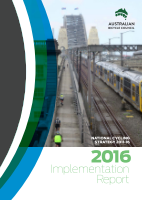Active Travel

National Cycling Strategy: Implementation Report 2016
- Publication no: AP-C93-17
- ISBN: 978-1-925451-68-9
- Published: 27 April 2017
- PDF (free) Download
This report provides an overview of progress made in 2016 towards the objectives of the National Cycling Strategy 2011-16.
During 2016:
- State and Territory Governments continued to embed walking and cycling measures into a variety of planning instruments at both a strategic and an operational level.
- State and Territory Governments spent $121.8 million on improving on-road and off-road cycling networks to key destinations in both urban and rural areas.
- State and territory cycling promotion included programs that encourage cycling for short trips, recreational cycling and cycling to work. Programs that encouraged short trips include Ride2School (Vic, Tas, NT, ACT), Your Move (Qld) Cycle Instead (SA), Your Move (WA) and Active Streets (ACT).
- Planning for cycling continues to be integrated into wider government policy published in 2016, with both walking and cycling forming key components of the Smart Cities Plan (Australia), the Great Sydney Commission District Plans (NSW), 30 Year Infrastructure Strategy (Vic), Perth Transport Plan (WA) and NT Land Use Plans (NT).
- Several jurisdictions also released bicycle strategies or updated cycling plans, with the Queensland Government releasing six Principal Cycle Network Plans and the Western Australian Government releasing their Long Term Cycling Network Plan.
- The Australian Transport Assessment and Planning Guidelines were released which included, for the first time, mode-specific guidance that provides parameters that can be used for the assessment of active travel projects.
- Rider fatalities were heavily skewed towards older riders, with the average age being 58 years. Of the 29 bicycle riders killed in 2016, 86% were aged over 40 years and 55% were aged over 60 years. This result is particularly significant given that cycling participation in Australia has been shown to decrease significantly with age.
While the National Cycling Strategy was due to finish at the end of 2016, the strategy has been extended until the end of the 2017 calendar year. This provides an opportunity to conduct the fourth National Cycling Participation Survey in 2017. The future national approach to cycling (and walking) will be determined in 2017.
- Contents
- Australian Bicycle Council
- National Cycling Strategy 2011-16
- Highlights
- Investment in Cycling Infrastructure and Programs
- Bicycle Imports
- Summary of Work in Response to the National Cycling Strategy Aims
- InternationalContext
- Bicycle Share Systems
- Protected Bicycle Facilities
- Childhood Skills Education
- Bicycle Tourism
- CyclingPromotion
- Promoting Cycling for Short Trips
- Promoting Recreational Cycling
- Encouraging Cycling to Work by Developing Bicycle-Friendly Workplaces
- Infrastructure& Facilities
- New South Wales
- Victoria
- Queensland
- South Australia
- Western Australia
- Tasmania
- Northern Territory
- Australian Capital Territory
- IntegratedPlanning
- Capital City Bicycle Strategies
- State and Territory Cycling Strategies
- Safety
- Cycling Fatalities 2016
- Key Theme: Minimum Passing Distance Legislation
- Key Theme: Driver Licensing
- Monitoring& Evaluation
- Key Theme: Bicycle Counter Innovation
- Guidance &Best Practice
- Key Theme: Bicycle Parking Facilities Guidance
- Key Theme: Supplementary Guidance to Improve Safety and Amenity
- Key Theme: Leveraging International Expertise
Related publications
WEB-PROJECTS-23
Latest Active Travel News
